CENTRE FOR LIFE PROJECT
This project was brought to us through John Kearvell and was based around the new strategic partnership between Northumbria University and Centre for Life. This project was complex as there were many stakeholders with a range of needs to satisfy. The title of the project was: How can innovation and design communicate the value of research to the public? Lasting 2 weeks it had various elements; week one was a research and scoping week (understanding the context), and the second was a development and solution generation week (solution opportunities). The background is, in May The Bodyworlds exhibition is coming to the Centre for Life, during this exhibition, Northumbria will have some of their researchers displaying their work. The researchers involved have been focusing on body/facial/muscle movements, which is linked to The Bodyworlds exhibition. MDI were tasked with designing an innovative use of the space for the researchers to show their work. It had to be flexible as there are different researchers showing different work; it had to be portable, as they wanted to set up an outreach programme; it had to be within budget and also engaging for all ages. As well as this task we also needed to develop a business plan for the management of the strategic partnership and all the stakeholders involved.
This is the re-worked version of the brief by Max
 VISIT TO THE CENTRE FOR LIFE |  FIELD TRIP |  MDI FIELD TRIP |
|---|---|---|
 OUR EXHIBITION SPACE |  MEET THE SCIENTIST @ LIFE |  A PROPOSAL FOR EXHIBITION |
 SOME MOCK UP BOARDS |

WEEK ONE: UNDERSTANDING THE CONTEXT
The briefing was with John Kearvell on Monday morning, he explained the background about Centre for Life, Bodyworlds and Northumbria’s researchers, also pointing out they are still unsure how many researchers might be involved. One of the researchers Hubert Shum presented to us, he went through his work and explained that it could be used as a demonstration at the Centre for Life; his research was around muscle movement. Within the brief there were four specific tasks for week one and two, we were split into groups and given each a task. For week one my group, which consisted of Valeria, Jonathan, Haroon and Youzela were given the topic ‘Research the effectiveness of public science displays’. Valeria and myself organized a trip to The Hancock Museum before our group field trip on Wednesday. Unfortunately for us it was half term, which meant it was extremely busy, but it was interesting to see how different spaces and information was communicated, and what seemed to be the most popular or interesting. Anything that was interactive and involved the user made it a hit. We realized quite quickly that there would need to be a level of interaction within our display to make it more engaging. Valeria and I then began gathering our research together in an InDesign document.
On Wednesday as a cohort we visited the Centre for Life and met Neil Simmons. He showed us round the Centre for Life and explained where the space we could use would be. Later he answered any questions we had about limitations and Bodyworlds expectations of Northumbria. This was a really interesting day, seeing inside the science centre, and it had become clear that Centre for Life was not sure what they wanted and were quite limiting to our creativity. Valeria and myself started brainstorming how we might use the space we have. We did some individual research around other exhibitions utilizing small spaces and creating an engaging display.
WEEK ONE PHOTOGRAPHS
 VISIT TO THE HANCOCK MUSEUM |  INSIDE THE HANCOCK |
|---|---|
 DISPLAYS INSIDE |  VALERIA ENGAGING |
 SOME MORE DISPLAYS |  INTERACTIVE BUTTONS |
 THE EXHIBITION SPACE |  MEETING WITH NIEL SIMMONS |
 ONE OF THE SHOWS IN THE CfL |

WEEK TWO: SOLUTION OPPORTUNITIES
Meeting early the following week we collated information gathered individually as a group. The way people move and use the space was a big focus, and I suggested we use a three-part presentation. Firstly having stand alone boards that contain information but can be left when researchers are not there, then the second stage which was displays, with the use of some TV and laptops to show a video about their research. The third was with the interactive robot or sensors for the audience to physically interact with the display. We begin mocking up in the studio how people might move through the space. Catie joined our group at this point to develop a marketing campaign around the ‘Meet the Researcher’ title. The difficulty we had was with limited time left on the project, we needed to compile some visuals and only Valeria and myself in our group who are designers, so people's time and capabilities were not being fully utilised. I decided in order to maximise our time and resources we should re organize the whole cohort, as they wanted one collective body of work, and there were some teams overlapping. We met as a cohort and I asked every group to explain what their focus had been for the past week. After writing everything up on the wall and gathering in all the research, we then discussed how we could split ourselves more effectively as a cohort and what were the tasks to be achieved. Below is our next steps plan of action.
 ORGANISING THE COHORT |  OUR GROUP TO DO LIST |  INITIAL SPACE IDEATION |
|---|---|---|
 DEVELOPMENT OF DISPLAY |  PLAYING WITH FLOOR SPACE |  MOVING THE FURNITURE |
From there people split themselves up to ensure the information about the researchers, colour schemes, logos etc. was coherent. This also meant the work Valeria and I had done, could be developed further by dedicating a whole team to create visuals. Craig and Ashlee created a visual representation of some of our ideas, which was great for the final presentation. I took an organizational role after that, bearing in mind we only had a few days left before the final presentation. Alain and myself began integrating the work into one document, which we decided should be a booklet format. Our final vision for this project was:
Using CfL’s facilities and consumer facing profile, Meet the Researchers aims to communicate Northumbria’s Research output in an engaging and accessible way. Using Northumbria’s design expertise, a framework will be developed to encourage intra-university collaboration under the banner of Northumbria@Life. In future this joint partnership will enable data mining at a national and international scale for further research projects.
There were many challenges piecing together all this work because there was a huge body of research behind it and every individual wanted to include their work within the document. Alain and myself went through everything and came up with a structure of content and decided the most valuable work to include. There was a four stage plan created by Catie and Francis with costing’s and budgets in detail to accompany the future of the exhibition, but this all had to be displayed in a visual way. As both of us could not work on the document simultaneously Alain completed the final touches. The presentation was scheduled for the Friday but it was delayed which enabled us to make the presentations to Nick and John on the Friday. There were some suggested changes after that presentation for the final one. As we only began bringing all the work together nearer the end of the second week it meant some of it seemed quite disjointed. After what we thought was our final presentation on Monday there was some negative feedback around the work produced. Luckily, we got another opportunity to edit and change our work and present to Neil Simmons from Centre for Life and Northumbria University’s staff partners in this project. The final presentation overall was successful, there were a few points raised by Mr. Simmons around the branding of the exhibition; but overall the university staff were happy with the outcome. We had organized for some print outs to be done for the client to take away with more in-depth information as the presentation was a summary of findings. Below is a copy of the final document.
 |  |  |
|---|---|---|
 |  |  |
 |  | 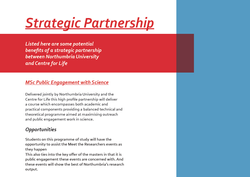 |
 |  |  |
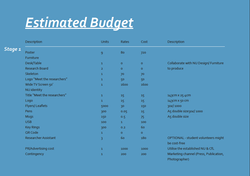 |  |  |
 |  |  |
 |  |  |
 |  |  |
 | 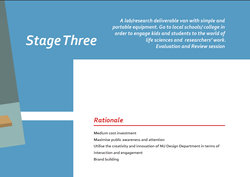 |  |
 | 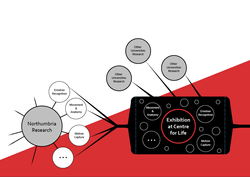 |  |
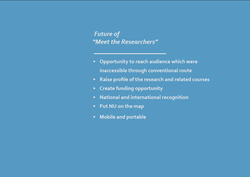 |  | 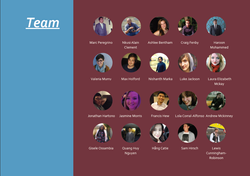 |
This project was one of the most challenging within the semester, the project brief was very interesting and it enabled me to work on an area I never have before. Understanding the needs of the different stakeholders and trying to ensure everyone was happy was a very difficult task, but I believe as a cohort we learnt a huge amount, which put us in a good position for the next project.